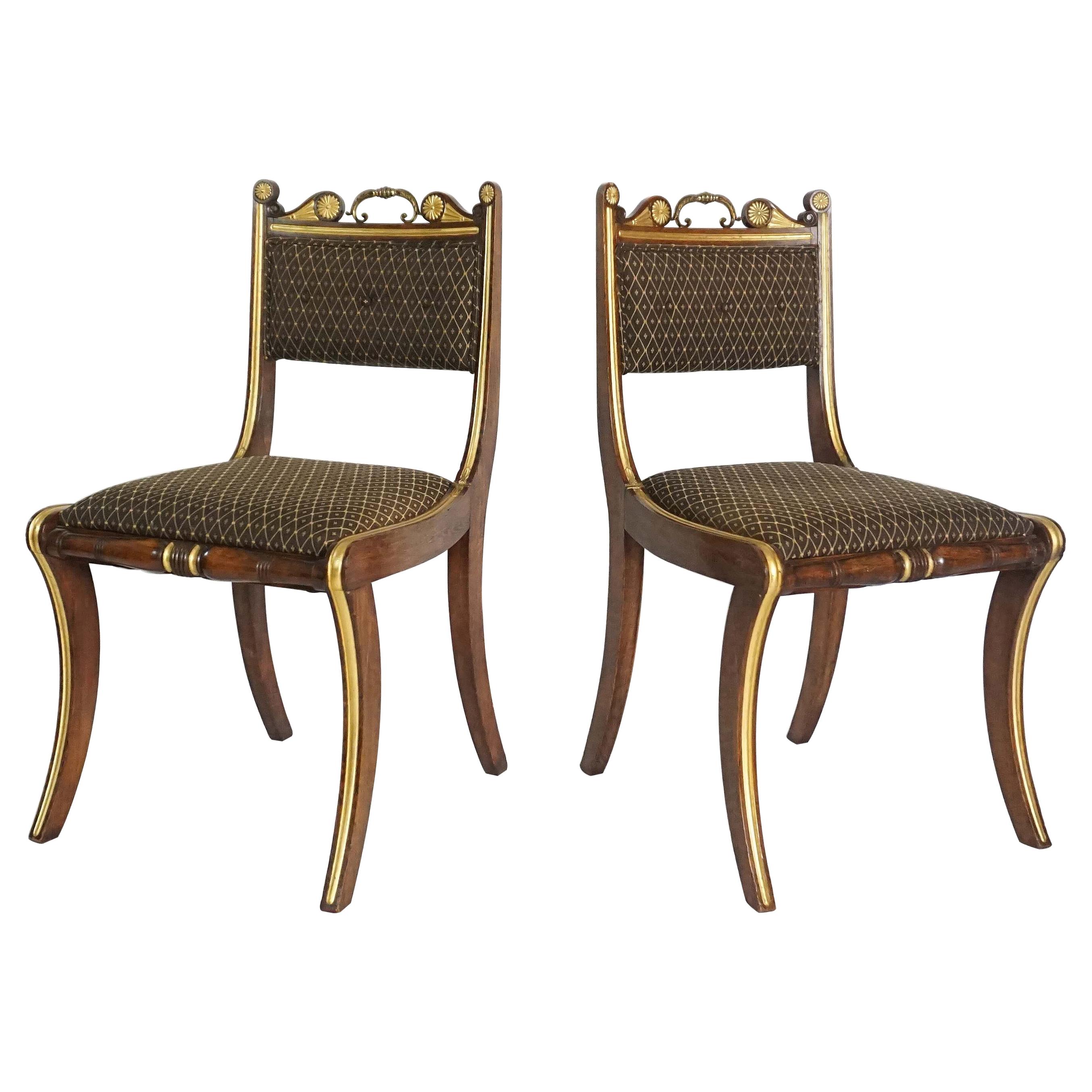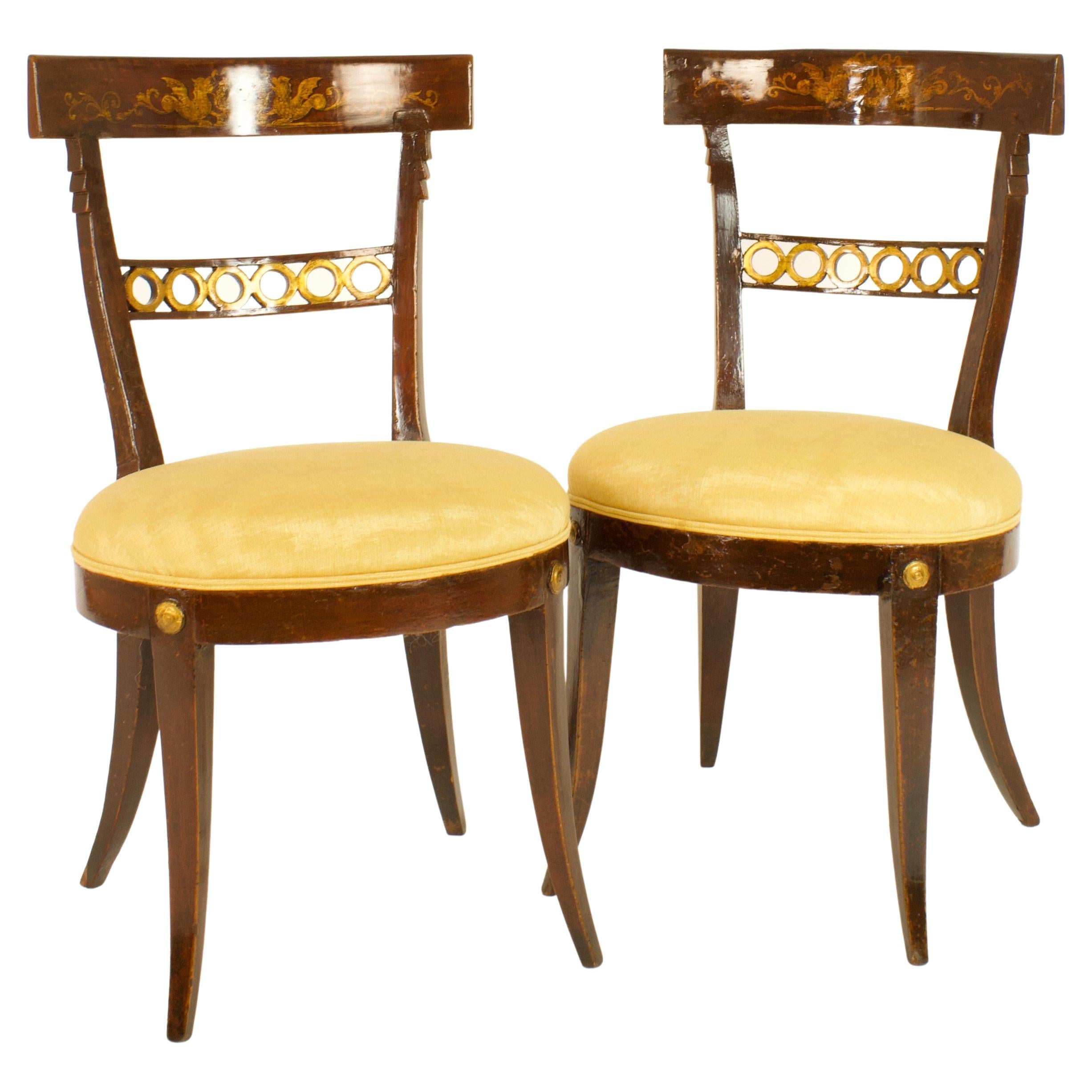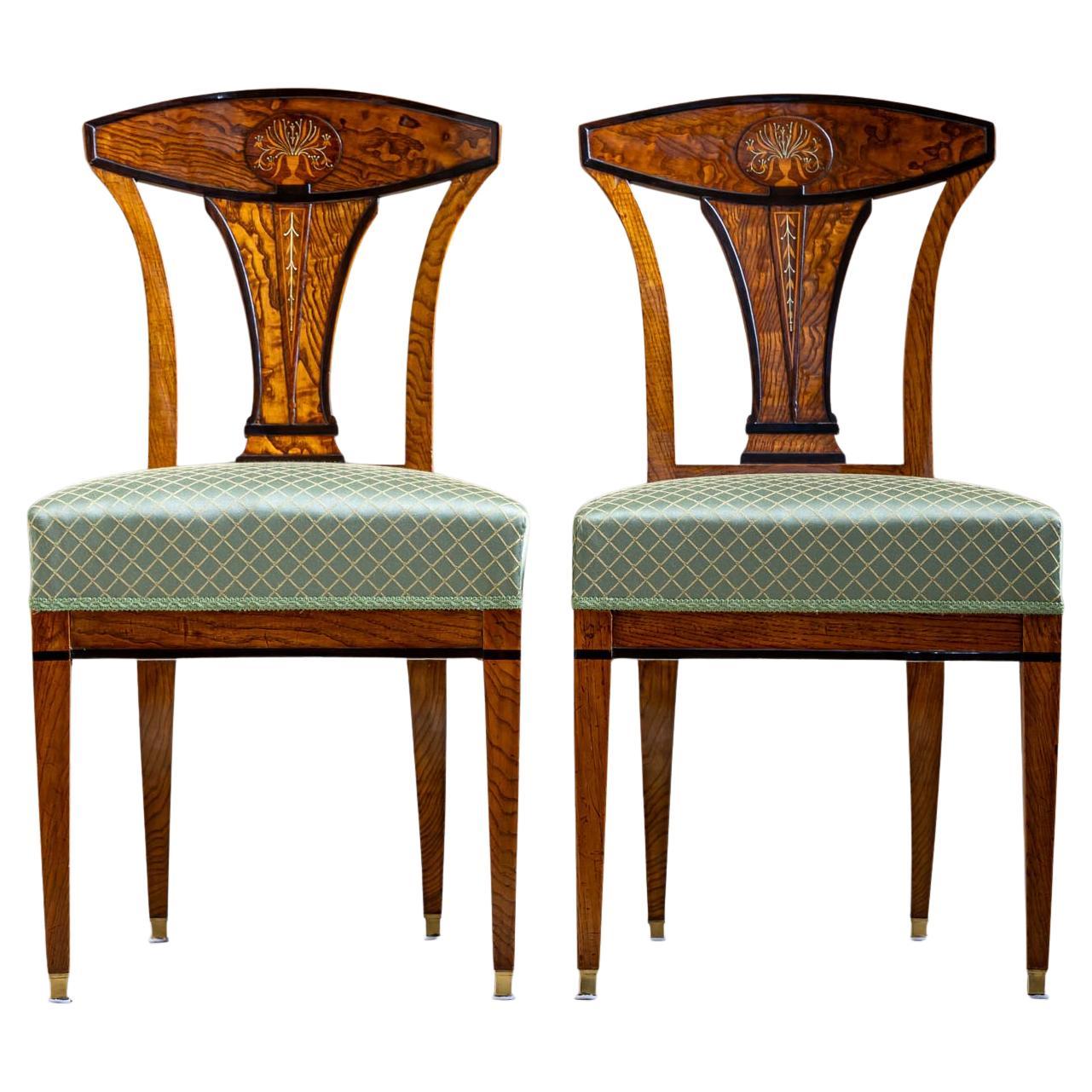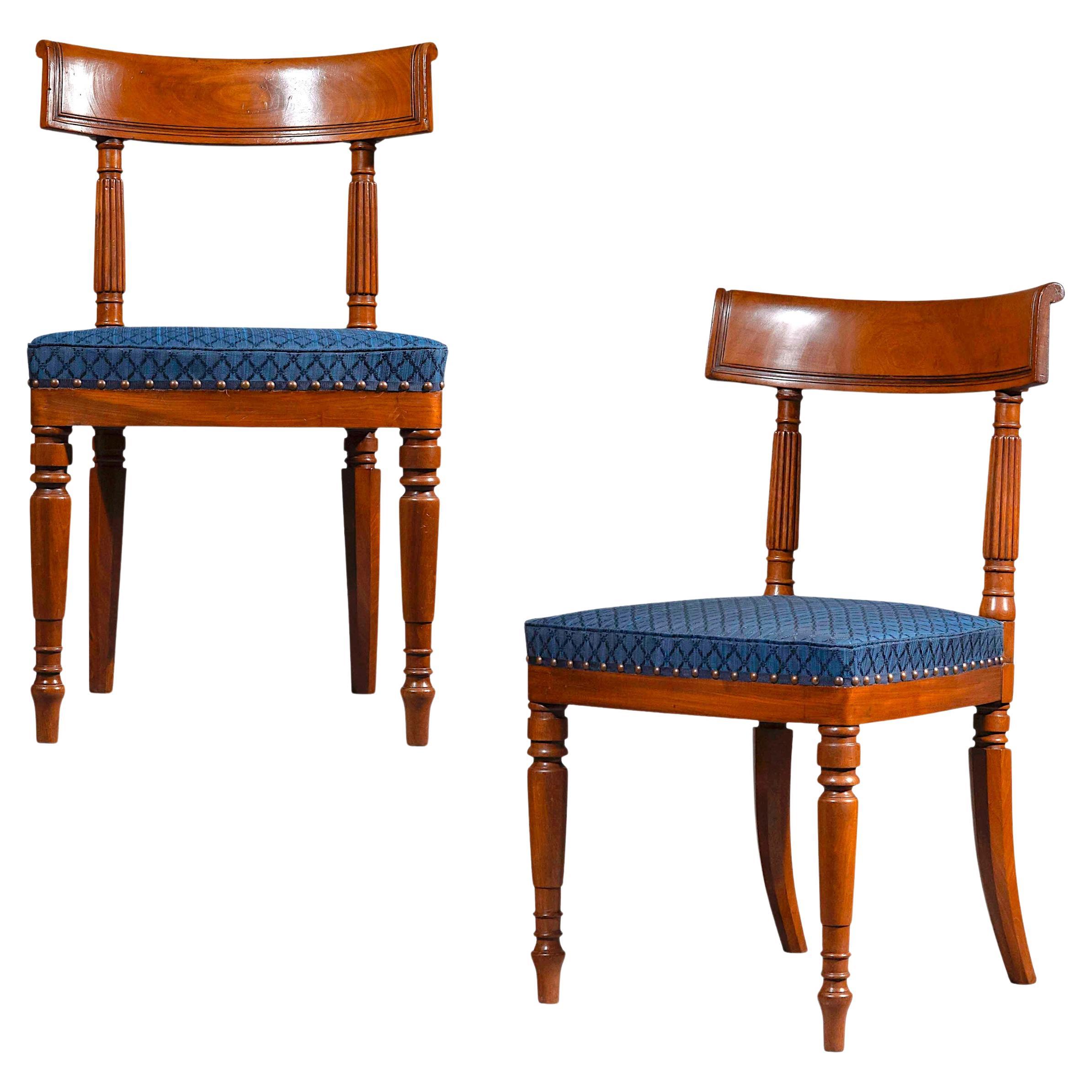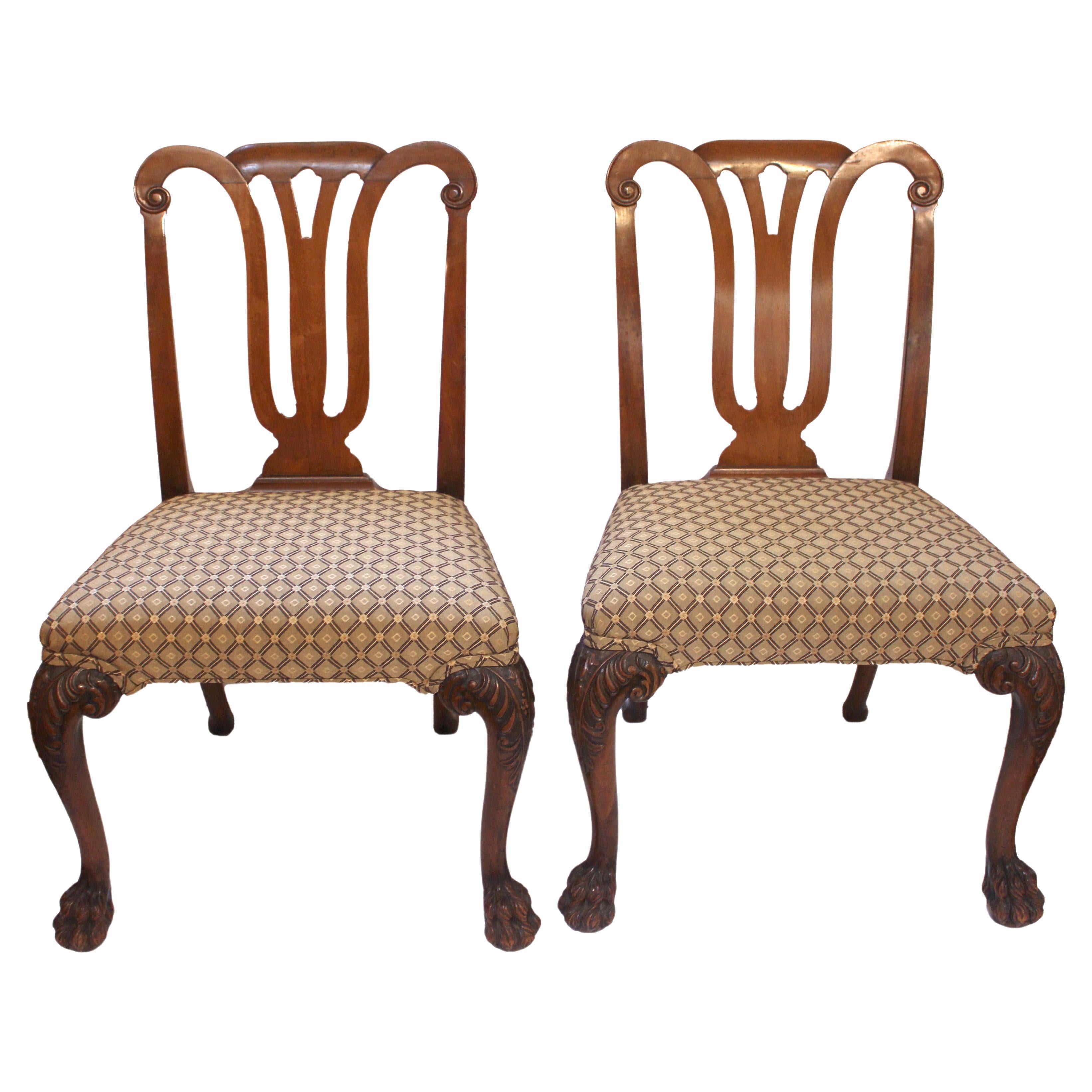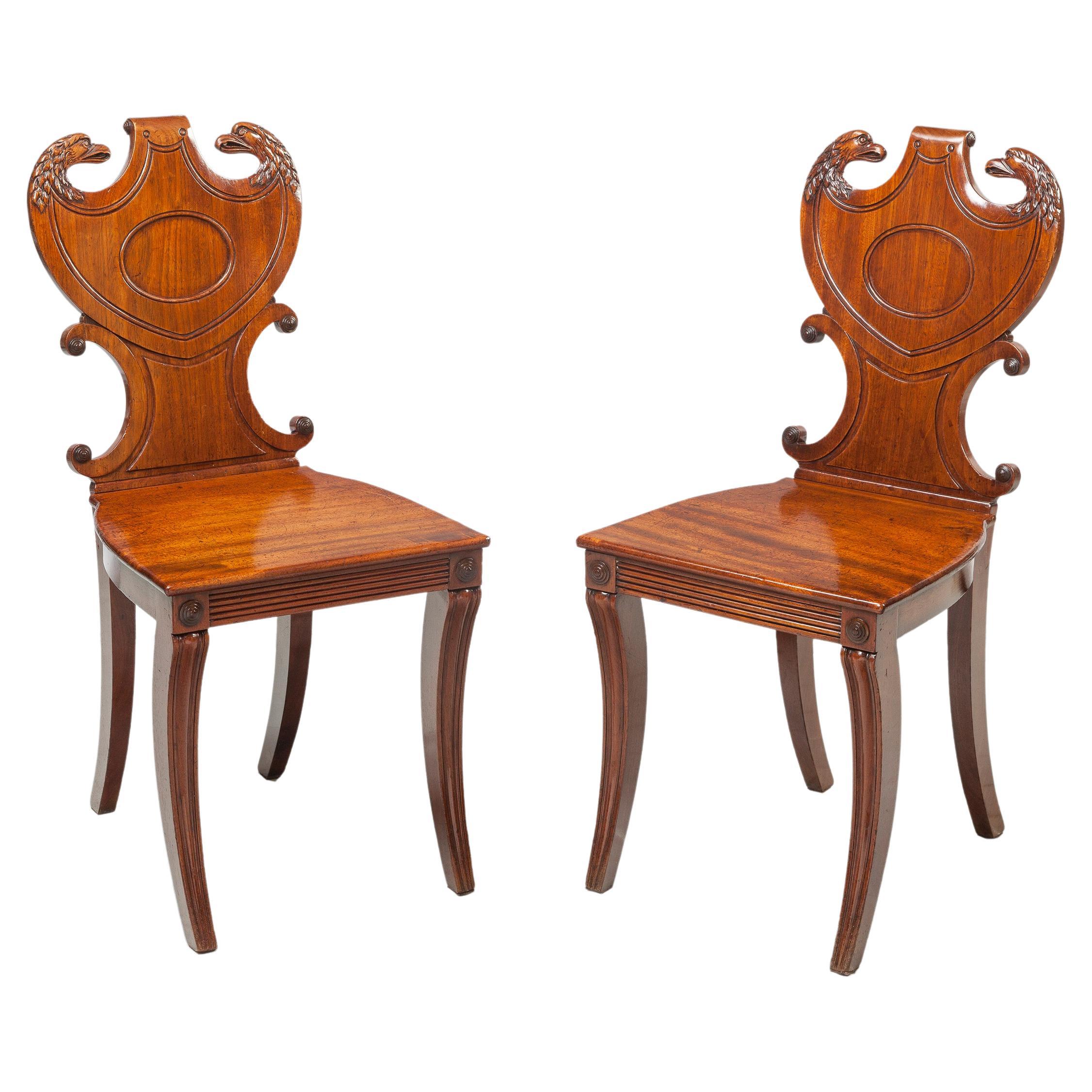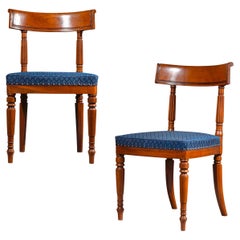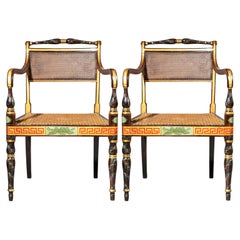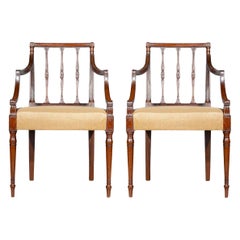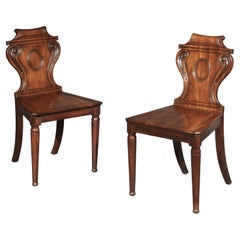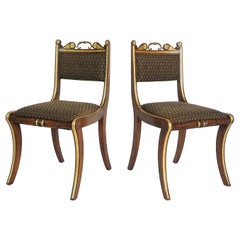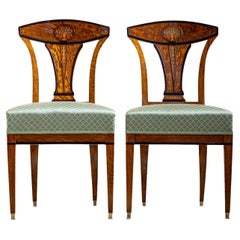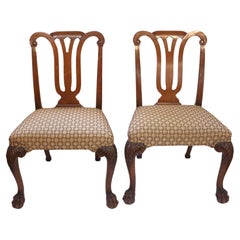Items Similar to Early 19th Century Pair of Klismos Chairs, George Oakley
Want more images or videos?
Request additional images or videos from the seller
1 of 9
Early 19th Century Pair of Klismos Chairs, George Oakley
$16,973.33per set
£12,550per set
€14,858.32per set
CA$23,467.11per set
A$26,287.11per set
CHF 13,806.94per set
MX$319,642.83per set
NOK 174,840.96per set
SEK 165,971.08per set
DKK 110,893.39per set
About the Item
An exceptional pair of Regency period chairs, with a well-shaped 'Klismos' outline and unusually generous proportions, attributed to George Oakley of Bond Street. London, circa 1810. Extremely rare and thought after model.
Why we like them
With front legs unusually splayed in two dimensions, this design is one of the most sophisticated examples from the Regency period. Unusual in form, subtle in ornamentation, and outstanding in quality, these chairs display the decorative techniques of cabinetmaking, rather than joinery. The veneers and Greek-key brass inlays cover the seat rails and front leg joints—a highly unusual feature for chairs—demonstrating superb cabinetmaking skills and suggesting a high-end workshop origin.
Attribution:
The extremely rare ‘double-splayed’ front legs, derived from ancient Greek Klismos seats, along with exquisite brass inlays, contribute to these chairs' distinctive elegance. This form, along with certain decorative elements, aligns with other pieces traditionally attributed to George Oakley (1773–1840), one of the foremost London cabinetmakers of the period.
The scrolling foliage pattern of the inlays on the back tablets of these chairs matches the decoration on a spider-leg sofa table illustrated in F. Collard’s Regency Furniture (Woodbridge, 1987, p. 317) and Mallett’s The Age of Matthew Boulton - Masterpieces of Neo-classicism (London, 2000, pp. 112-113). This table, belonging to a group of furniture firmly attributed to Oakley, likely originates from the same workshop as these chairs. An identically decorated daybed, en suite with these chairs, appears in the same Mallett catalogue (pp. 94-95). A magnificent center table, featuring the same inlays and possibly from the same suite, was sold at Christie’s, New York, 29 January 1994, lot 342.
An identical pair of chairs is illustrated in Ronald Phillips’s Fine Antique English Furniture 2018, pp. 158-159.
George Oakley
George Oakley’s firm produced stylish Grecian-inspired furniture around the turn of the 19th century, pioneering ‘Buhl’ inlay, a decorative technique that regained popularity in the Regency’s early years. Fashionable materials like rosewood, mahogany, and calamander were often used in Oakley's furniture, combined with satinwood, ebony inlays, brass stars, and metal bands. His high-class furniture earned him a royal appointment and a reputation for fine craftsmanship.
Visits by the royal family to Oakley's Bond St. Showrooms are recorded as in the Morning Chronicle of 1799. In May, “the ROYAL FAMILY, with the PRINCE and PRINCESS of ORANGE did Mr. OAKLEY the honor of viewing his Printed Furniture Warehouse in New Bond Street; when her MAJESTY, the Duke and Duchess of YORK, and the PRINCESSES, &c., highly approved of the splendid variety which has justly attracted the notice of the fashionable world.” Two weeks later, “Notwithstanding the fatigues which the Royal Family underwent [at the King's Birthday Parade], the Queen and Princesses, accompanied by the Duke and Duchess of York, made a tour of the most elegant shops and manufactories in the different lines of the useful Arts. We saw them at Oakley and Shackleton's magazine of furniture in Old Bond Street … and thus Their Majesties, in the prevailing taste for magnificence in every article of decoration, give the most flattering encouragement to the arts by their countenance and protection.” On the evening of the King's Birthday celebrations, “the illuminations were mostly confined to the gaming houses and the tradesmen. OAKLEY's furniture magazine was the most tasteful and novel in its design.” [Morning Chronicle, 23 May, 5, 6 and 17 June] Shortly after this royal tribute, Oakley received the Royal Appointment, and on 2 July, an entry in the Morning Chronicle advertising the wide stock of fabrics available at 67 New Bond St. is headed “GEO. OAKLEY and Co. FURNITURE PRINTERS to her MAJESTY.”
- Attributed to:George Oakley (Maker)
- Dimensions:Height: 35 in (88.9 cm)Width: 20 in (50.8 cm)Depth: 21.25 in (53.98 cm)Seat Height: 18.5 in (46.99 cm)
- Sold As:Set of 2
- Style:Regency (Of the Period)
- Materials and Techniques:
- Place of Origin:
- Period:
- Date of Manufacture:circa 1810
- Condition:Wear consistent with age and use. Ready for placement and immediate use. New traditional hand-stitched upholstery and newly polished.
- Seller Location:Richmond, GB
- Reference Number:1stDibs: LU1781238401282
About the Seller
5.0
Gold Seller
Premium sellers maintaining a 4.3+ rating and 24-hour response times
Established in 2014
1stDibs seller since 2016
236 sales on 1stDibs
Associations
LAPADA - The Association of Arts & Antiques Dealers
- ShippingRetrieving quote...Shipping from: Richmond, United Kingdom
- Return Policy
Authenticity Guarantee
In the unlikely event there’s an issue with an item’s authenticity, contact us within 1 year for a full refund. DetailsMoney-Back Guarantee
If your item is not as described, is damaged in transit, or does not arrive, contact us within 7 days for a full refund. Details24-Hour Cancellation
You have a 24-hour grace period in which to reconsider your purchase, with no questions asked.Vetted Professional Sellers
Our world-class sellers must adhere to strict standards for service and quality, maintaining the integrity of our listings.Price-Match Guarantee
If you find that a seller listed the same item for a lower price elsewhere, we’ll match it.Trusted Global Delivery
Our best-in-class carrier network provides specialized shipping options worldwide, including custom delivery.More From This Seller
View AllPair of Regency Chairs, Attributed to George Bullock
By George Bullock
Located in Richmond, London
Collectors' choice - a very fine and rare Regency period pair of mahogany chairs, firmly attributed to George Bullock. England, circa 1815. Highly desirable and sought after model.
...
Category
Antique Early 19th Century European Regency Chairs
Materials
Wood
19th Century Regency Painted Armchairs
Located in Richmond, London
An elegant pair of painted open armchairs from the early 19th century English Regency era, exquisitely hand-painted to simulate exotic timber and decorated with neoclassical festive ...
Category
Antique Early 19th Century English Regency Armchairs
Materials
Wood, Cane, Paint
$9,602 / set
18th Century George III Armchairs Circa 1780
By Thomas Sheraton
Located in Richmond, London
An extremely elegant, rare quality pair of George III period armchairs. English, circa 1780.
Why we like them
Wonderfully elegant model, looking very delicate but in fact unusually...
Category
Antique Late 18th Century European George III Armchairs
Materials
Upholstery
$10,143 / set
Pair of Regency Hall Chairs, attributed to Banting and France
By France & Banting 1
Located in Richmond, London
A fine pair of hall chairs of the Regency period, attributed to Thomas Banting and William France.
England, circa 1820.
Why we like them
These fine hall chairs have a particularly elegant and sophisticated scrolled cartouche design of the backs, with the finest carving and figuring of the timber. Also of great colour and natural patination, these chairs are highly decorative and rare.
Attribution
The design of these chairs is identical to a set of hall chairs...
Category
Antique Early 19th Century English Regency Chairs
Materials
Hardwood
19th Century Regency Pair of Chairs, circa 1820
Located in Richmond, London
A superb quality pair of Regency period library or salon chairs, attributed to Gillows of Lancaster and London.
English, circa 1825.
Why we like them
Quite possibly the most comfor...
Category
Antique Early 19th Century European Regency Club Chairs
Materials
Upholstery, Wood
$6,762 / set
Pair of 19th Century Open Armchairs
By Gillows of Lancaster & London
Located in Richmond, London
A superb quality pair of open armchairs, after late 18th century designs by Gillows of Lancaster and London, the manufacture attributable to Gillow & Co. English, circa 1880.
Why we like them
Wonderfully elegant model, looking very delicate but in fact unusually strong – the sign of a skilled craftsman. Interestingly, chairs of this exact model can be seen in a painting by Walter Dendy Sadler (British, 1854-1923), The After Lunch Conversation, 1889, sold at Doyle, New York, 21 May 2024, lot 83.
Design
These chairs correspond to Gillows’ 'Garforth pattern' - a rare and highly desirable design - which first appeared in 1795 and was probably an adaptation of Georges Jacob's design of circa 1792 for Marie-Antoinette's dairy at Rambouillet. Gillows made the chairs not only in mahogany but also japanned, and they appear to have been particularly popular among the genteel, professional, and merchant classes in the north of England. In 1796, the Earl of Strafford purchased six white and green japanned chairs for Wentworth Woodhouse...
Category
Antique Late 19th Century European Armchairs
Materials
Upholstery
$5,369 / set
You May Also Like
Pair of English Regency Side Chairs attributed to Morel & Hughes, circa 1815
By Morel and Hughes
Located in Kinderhook, NY
Pair of circa 1815 English Regency period side chairs attributed to renowned cabinetmakers Morel & Hughes having parcel-gilt and gilt-metal mounted rosewood 'klismos-form' frames; th...
Category
Antique Early 19th Century English Regency Side Chairs
Materials
Ormolu
Pair of Late 18th Century Italian Neoclassical Klismos Style Side Chairs
Located in Berlin, DE
Pair of Late 18th Century Italian neoclassical Klismos Style side chairs
Exceptional pair of dark red varnished side chairs: the wide curving bac...
Category
Antique 1780s Italian Louis XVI Chairs
Materials
Giltwood, Wood
19th Century Biedermeier Side Chairs, Vienna around 1810
Located in New York, NY
Elegant pair of Viennese chairs, the outstanding quality of the Empire chairs can be seen in the design of the backrest with floral bouquets and the finest brass inlays.
Category
Antique Early 19th Century Austrian Chairs
Materials
Brass
Late 19th Century Pair of George II Style Irish Side Chairs
Located in Chapel Hill, NC
Late 19th century pair of George II style Irish mahogany side chairs. Walnut. Knees boldly carved with scrolling acanthus leaves descending to cabriole leg to hairy lion paw feet. Sc...
Category
Antique Late 19th Century Irish George II Side Chairs
Materials
Wood
$700 Sale Price / set
20% Off
English Regency Hall Chairs, circa 1815
Located in Saint-Ouen, FR
Fine 19th century pair of English Regency hall chairs, circa 1815.
Category
Antique 1810s British Chairs
Materials
Wood
$3,961 / set
Early 19th Century George IV Pair of Chairs by Gillows of Lancaster and London
By Gillows of Lancaster & London
Located in Dublin 8, IE
Early 19th century George IV pair of occasional chairs by Gillows of Lancaster and London, the curved top rail with centred flower head...
Category
Antique 1820s English George IV Side Chairs
Materials
Mahogany
More Ways To Browse
King George Furniture
Antique Duchess
Used Furniture Prince George
Antique Wood Saw
Antique Hand Rails
Antique Ancient Key
Outline Sofa
Greek Key Legs
Bond St London
Antique Table And 2 Chairs
Ebony Head
C Shaped Couch
Antique Sofas London
Antique Table Saw
Antique Wood Hand Saws
King George Table
Royal Ebony
Early Regency Sofas
